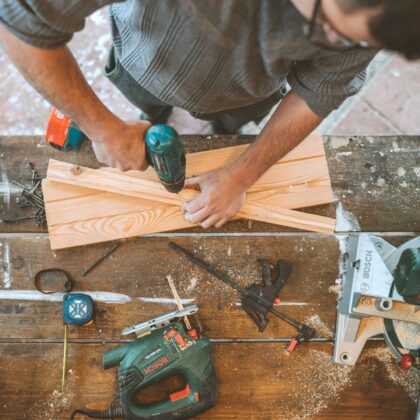Your ultimate guide to Hong Kong typhoon season, what T1, T3, T8 and other signals mean, what to do when you see Amber or Black Rainstorm Warnings and more.
If you grew up in this city — like many members of our team! — you’ll know a Hong Kong typhoon is just regular routine! But it can be nerve-wracking if you’re new to the city or living alone for the first time. Here’s a handy guide to explain the Hong Kong Observatory (HKO)‘s warning signals, how you should prepare your home for a typhoon and where to get help and up-to-date information during a typhoon or rainstorm.
Read More: Things To Do Indoors When It’s Raining In Hong Kong

What Exactly Is A Typhoon?
To get really specific, a typhoon is a tropical cyclone, that develops between 180° and 100°E in the Northern Hemisphere (North America, the northern part of South America, Europe, the northern two-thirds of Africa and most of Asia). A mature tropical cyclone in the northeast Pacific and northern Atlantic is called a hurricane (the main difference between a hurricane and a typhoon is the location where the storm occurs).
Typhoon forecast and warning centres are found in places like Japan, Hawaii, the Philippines and Hong Kong — about 18 countries have territories threatened by typhoons each year!
In Hong Kong, typhoon season starts in April and lasts until November and they’re most likely to hit between July and September. Expect strong winds and heavy rain, which can cause flash flooding, landslides and damage to property. There’s typically a few days’ warning that a storm is coming so you’ll have time to prepare, and Hong Kong is very well-equipped to handle these things, particularly if you live in the city!

Typhoon Warning Signals
The HKO’s MyObservatory app (on Apple or Android) has a wealth of information, right at your fingertips. Day-to-day it is great for forecasts but during a typhoon, this will be your go-to for tracking advice. The warnings start at T1, then T3, T8, T9 and T10 (T2, 4, 5, 6 and 7 all disappeared in the 1970s as it was making things too confusing!).
Unlike hurricanes and cyclones which are given categories based on the storm intensity, in Hong Kong, the typhoon warning signals are based on the storm’s proximity and effect on the territory.
T1 – Typhoon Warning Signal One
Don’t worry too much when you see a T1 alert — it just means there’s a typhoon within 800km of Hong Kong. It might come towards Hong Kong or might miss it completely.
T3 – Typhoon Warning Signal Three
The storm is getting a little closer to Hong Kong and winds of 41 to 62km/hour will start to affect the city. Your daily life may be affected as private businesses might shut and boating activities will typically be cancelled (check the policy on those summer junk boat trips!). Take time to secure all loose objects, particularly on balconies and rooftops.
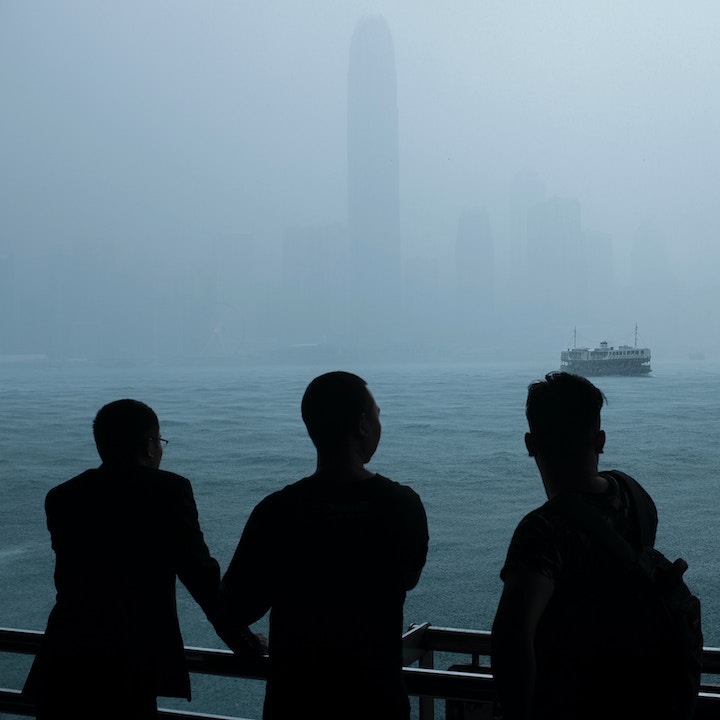
T8 – Typhoon Warning Signal Eight
This is when things start to get serious and the city begins to shut down. Offices, schools, shops, public pools and all outdoor facilities close, most public transport and taxis will stop and flights are suspended.
There is normally a few hours’ warning (the Observatory should make a pre-No.8 special announcement when the T8 signal is expected within two hours!) so you have time to make transport arrangements, pick up any last-minute supplies and get to a safe location.
Complete all safety precautions! Weatherwise, you can expect gale-force winds between 63 and 117km/hour (with gusts up to 180km/hour!) and heavy rain.
T9 and T10 – Typhoon Warning Signals Nine And Ten
These are the most severe typhoons in Hong Kong and are rare (since 1946, the T10 signal has been raised 16 times) however, Typhoon Hato hit the city in 2017 and Mangkhut in 2018, causing widespread damage and making international headlines.
You can expect hurricane-force winds of 118+km/hour with gusts of more than 220km/hour as the storm passes directly over Hong Kong. If you live in a high-rise apartment, you may feel your building sway (don’t worry, the buildings are designed for this) and there is some risk of damage to windows.
Stay indoors and away from exposed windows and doors to avoid flying debris. In more remote areas, you may lose power and have restricted road access after the storm has passed due to flooding and debris on the roads.

Rainstorm Warning Signals
The general rainy season in Hong Kong is normally between April and September, and it can be particularly heavy and persistent during May and June.
HKO’s rainstorm warning system is designed to let you know about heavy rain and is independent of other severe weather warnings like tropical cyclones and landslips (issued separately when necessary!). There are three levels of warning:
Amber Rainstorm Signal
An amber signal means there’s potential heavy rain that may develop into red or black rainstorms. You may see flooding in some low-lying and poorly drained areas. Take necessary precautions to reduce your exposure to risk!
Red Rainstorm Signal
Rain is now heavy and could bring about serious road flooding and traffic congestion. If you have to travel, take precautions! If this signal is issued before work, you can go in as usual provided that transport services are available. If it’s issued during office hours, stay indoors.
Black Rainstorm Signal
Very heavy rain has fallen, exceeding 70 millimetres in an hour! Stop work, stay indoors and take shelter. Try to not go into work and if you’re already there, stay in your office unless it’s dangerous to do so. If combined with a strong typhoon, you’re likely to be evacuated (aka. directed to go home!) a few hours before the rainstorm and typhoon signal is raised.

How To Prepare Your Home For A Typhoon
The level of preparation you need to do before a typhoon will largely depend on where you live. There’s going to be a lot more to do for those living in village houses in the New Territories, on Outlying Islands and those living on boats in Hong Kong but even those in the city should do a check of their supplies.
- Bring outdoor furniture inside or tie it down securely. I can’t tell you the number of flying outdoor cushions and even furniture I saw flying through Mid-Levels during Typhoon Mangkhut!
- Stock up on long-life food and water. This is especially important if you are in a more remote part of Hong Kong where there is more risk of power and water outages or longer road closures after the storm has passed. In the city, you won’t have your usual fallback of home delivery services, so make sure you have at least 24 hours’ worth (but preferably enough to last two to three days) of food for the family (including your furry friends).
- Charge important electrical items like phones and laptops (as well as power banks as backup!). Your apartment on Hong Kong Island may have never lost power or internet but you can’t be certain and you don’t want to waste your battery scrolling through social media.
- Prepare an emergency bag or box with flashlights (check the batteries!), a hard copy of emergency phone numbers (including family and friends) in case your phone dies as well as some first aid supplies, just in case.
- Boat owners should ensure vessels are appropriately moored and seek shelter on land.
Read More: Our Go-To Handyman & Home Repair Services In Hong Kong
Riding Out The Storm
Once the T8 signal is raised and you’re safe at home, there’s not much to do but hang around and ride out the storm. Settle in for a show or movie, listen to some podcasts or use the time to declutter the house.
The most important thing: DO NOT GO OUTSIDE! Even if it looks calm outside winds can come out of nowhere. Don’t risk it and stay put until the warning signals are lowered.
Read More: What To Watch Next – The Best Shows Based On What You Already Love
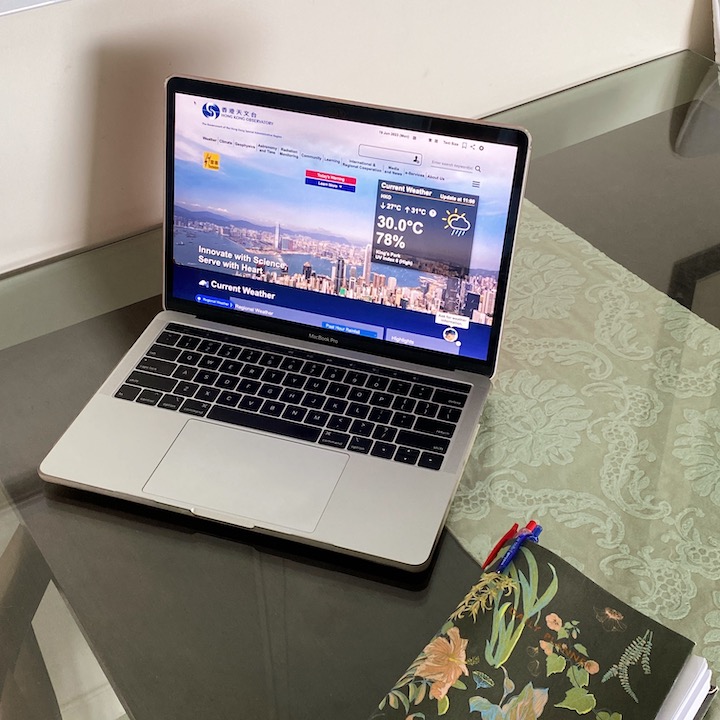
Where To Get Information About Hong Kong Typhoons
No doubt during a strong typhoon your social media, news feeds and WhatsApp will be filled with all things typhoon-related. The key is finding reliable, accurate and up-to-date information. Look to the Hong Kong Observatory, either via its website, mobile app or Dial-aWeather system hotline (information will also be broadcast on radio and TV).
You can’t tell what the exact weather in different parts of Hong Kong will be from the signal issued alone, which is HKO provides updated tropical cyclone information and related announcements (like typhoon tracking and intensity as well as rain, landslide and flood warnings in specific areas) so you can decide what to do! News outlets are sure to be constantly updating coverage around the territory.
Remember, tropical cyclone warning signals are to warn the public of the threat of winds associated with a tropical cyclone, so you should consider your local topographical conditions (like the presence of buildings, streams and water s nearby and the wind strength in your locality) over Hong Kong. Winds are often stronger over offshore waters and on high ground and less in areas sheltered from the prevailing wind direction.
Read More: Your Guide To Essential Hong Kong Apps And Numbers
Where To Get Help During A Typhoon In Hong Kong
Here is a handy list of Hong Kong emergency phone numbers:
- Emergency Services — Police, fire or ambulance. 999
- Government Hotline — To report fallen trees, road conditions, landslides and building conditions. 1823
- Hong Kong Observatory — For the latest weather warnings and updates. 1878 200
- Drainage Services — To report flooding. 2300 1110
- Home Affairs Department — Can assist with emergency accommodation and enquiries. 2835 2500
- SPCA — For animals in danger. 2711 1000
- St John Ambulance — 24-hour ambulance service to private hospitals. 1878 000
- Education Bureau — School closure information. 2891 0088
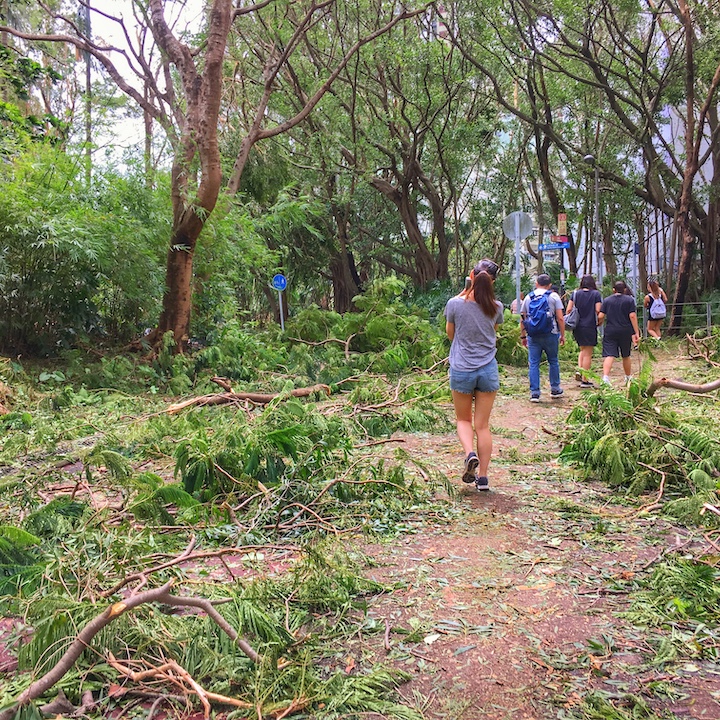
Cleaning Up After A Typhoon In Hong Kong
You might be surprised at how quickly the city returns to normal after a typhoon. Roads are cleared of debris ASAP so that public transport can get up and running and businesses start to reopen as soon as it is safe to do so (often not long after the signals are lowered). You may notice repairs in the weeks following the storm, but in general daily life resumes before you know it!
Read More: 10 Ways To Meet New People In Hong Kong
Editor’s Note: “Hong Kong Typhoons: Your Ultimate Survival Guide” was originally published on our sister site Sassy Mama Hong Kong by Jess Mizzi and updated for Sassy Hong Kong in June 2023 by Sakina Abidi.
Main image courtesy of Catgirlmutant via Unsplash, image 1 courtesy of EOSDIS Worldview via Wikimedia Commons, image 2 courtesy of K8 via Unsplash, image 3 courtesy of Hakan Nural via Unsplash, image 4 courtesy of K8 via Unsplash, image 5 courtesy of cattan2011 via Wikimedia Commons, image 6 courtesy of Sakina Abidi for Sassy Media Group, image 7 courtesy of cattan2011 via Wikimedia Commons.





 Eat & Drink
Eat & Drink



 Travel
Travel

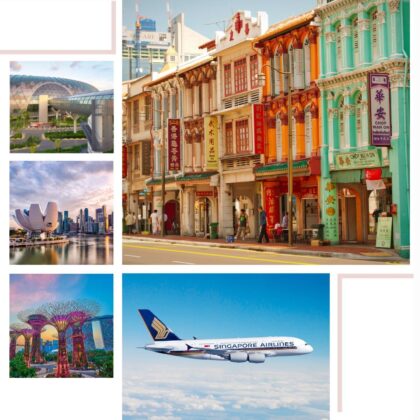

 Style
Style



 Beauty
Beauty



 Health & Wellness
Health & Wellness



 Home & Decor
Home & Decor


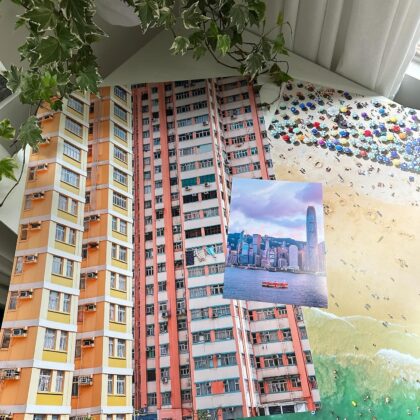
 Lifestyle
Lifestyle
 Weddings
Weddings








